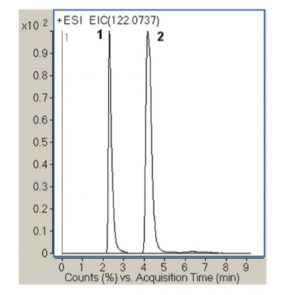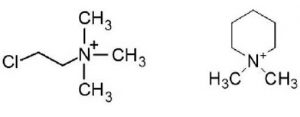Plant Growth Regulators CQ & MQ Retained and Separated
Analysis of Chlormequat and Mepiquat can be challenging since they are extremely hydrophilic and are only weakly Retained in Reversed Phase HPLC which makes their Separation difficult. In addition, these compounds are Retained too strongly in Normal Phase (Non Polar Solvents) Chromatography. Due to this situation, the preferred Method of Analysis for these compounds was Ion-Pair Chromatography using high ionic strength (> 150mM) Ion-Pair Reagents.
Buffers used are at a very high concentration which makes coupling with MS very difficult if not impossible (source contamination). This Method shows a new, Sensitive and Selective LCMS Method with low ionic strength Mobile Phase for the Analysis of Chlormequat and Mepiquat residues. The method can be used in Analysis of many samples including food.
The Selectivity and Sensitivity of the Method can be increased by using LCMS / MS instrument and adequate product ions.


Peaks:
1. Chlormequat (CQ) 122.0737 m/z (M)+
2. Mepiquat (MQ) 114.1277 m/z (M)+
Method Conditions
Column: Cogent Diamond Hydride™, 4μm, 100Å
Catalog No.: 70000-15P-2
Dimensions: 2.1 x 150mm
Mobile Phase: 70:30 Buffer / Acetonitrile
—Buffer: DI Water / 20mM Ammonium Acetate (pH adjusted to pH 3.3 with Formic Acid)
Post Time: 5 minutes
Flow rate: 0.5mL / minute
Detection: ESI – pos – Agilent 6210 MSD TOF Mass Spectromer
Sample Preparation: Sample stock solutions were purchased from Sigma. Samples for injection were diluted 1:1000 in the Mobile Phase.
Notes: Chlormequat and Mepiquat are quaternary Ammonium compounds (quats) which are used as plant growth control regulators to reduce unwanted shoot growth without lowering plant productivity. Chlormequat and Mepiquat are used on fruits, vegetables and on food crops, which are used for making cereals. The compounds are considered by World Health Organization (WHO) as hazardous and their maximum residue levels (MRLs) have been established and regulated. For example in cereals, MRLs range from 0.5 to 5mg per kg for both compounds.
Attachment
No 98 Chlormequat & Mepiquat Analyzed by LCMS pdf 0.2 Mb Download File


